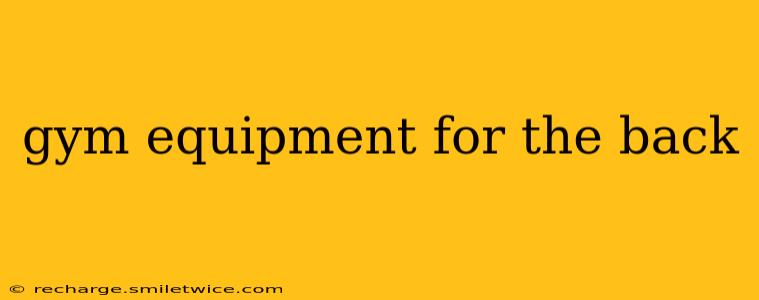Building a strong back isn't just about aesthetics; it's crucial for posture, injury prevention, and overall functional fitness. A strong back supports your entire body, enabling you to perform everyday tasks with ease and participate in more demanding activities without pain. This comprehensive guide explores the best gym equipment for targeting various back muscles, helping you create a well-rounded back workout routine.
What are the best gym machines for back exercises?
The "best" machine depends on your specific goals and what muscles you want to emphasize. However, some machines consistently deliver excellent results for back development. These include:
-
Lat Pulldown Machine: A staple for targeting the latissimus dorsi (lats), the large muscles that run down your back. Different grips (wide, close, neutral) allow for variations in muscle activation.
-
Rowing Machine (Cable or Machine): Rowing machines effectively work the entire back, engaging the lats, rhomboids, traps, and erector spinae. Cable row machines offer greater flexibility in terms of grip and movement paths.
-
Seated Row Machine: This machine isolates the back muscles, minimizing the involvement of other muscle groups. It's great for building strength and improving form before progressing to more challenging exercises.
-
Pull-up Bar: While not a machine, the pull-up bar is an incredibly effective piece of equipment for developing back strength and overall body control. Variations in grip (overhand, underhand, neutral) target different muscle fibers.
What gym equipment is good for lower back?
Strengthening your lower back is essential for preventing injury and maintaining proper posture. Focus on exercises that target the erector spinae muscles. Good options include:
-
Hyperextension Bench: This machine allows for controlled hyperextensions, targeting the lower back muscles effectively. You can add weight for increased resistance as you get stronger.
-
Roman Chair: Similar to the hyperextension bench, the Roman chair allows for various back extension exercises, targeting the lower back and glutes.
-
Good Mornings (with barbell or dumbbells): This free-weight exercise is a more advanced movement that heavily engages the lower back and hamstrings. Proper form is crucial to avoid injury.
What equipment can I use to strengthen my upper back?
The upper back comprises the trapezius (traps), rhomboids, and other muscles that contribute to posture and shoulder stability. Key equipment for targeting these muscles includes:
-
Face Pull Machine: This is an excellent exercise for strengthening the rear deltoids and upper back, improving shoulder health and posture.
-
Dumbbells or Barbell Rows: These free-weight exercises offer great versatility and allow for a natural range of motion, effectively engaging the upper back muscles.
How can I exercise my back without gym equipment?
While gym equipment provides targeted resistance and controlled movement, you can still effectively strengthen your back without it using bodyweight exercises. These include:
-
Pull-ups (using a sturdy bar at home or outdoors): A highly effective bodyweight exercise for building back strength.
-
Inverted Rows (using a sturdy table or bar): A great alternative to pull-ups, scaling the difficulty depending on your body position.
-
Back Extensions (using a sturdy surface for support): A bodyweight alternative to using a hyperextension bench.
What are the best back exercises for building muscle?
The best back exercises for building muscle incorporate a variety of movements that target different muscle fibers. A balanced routine should include pulling exercises (like lat pulldowns and rows) and extension exercises (like hyperextensions and good mornings). Remember to prioritize proper form to maximize muscle activation and minimize injury risk. Progressive overload (gradually increasing weight or reps over time) is also crucial for muscle growth.
What is the best exercise for lower back pain?
It's crucial to consult a physical therapist or doctor if you experience lower back pain. They can diagnose the cause and recommend appropriate exercises. Generally, exercises that improve core strength and stability, such as planks and bridges, are helpful. However, avoid exercises that aggravate your pain.
This guide provides a starting point for building a comprehensive back workout routine. Remember to listen to your body, prioritize proper form, and gradually increase the intensity of your workouts. A strong back is a cornerstone of overall fitness and health, and with the right equipment and dedication, you can achieve your fitness goals.
